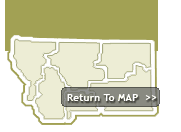

| Home | Communities | Accommodations | Places To Go | Things To Do | Site Map |
|
Glacier Country
Central Montana
Missouri River Country
Southwest Montana
Yellowstone Country
Southeast Montana
|

| ||||
 Fort Peck was planned and developed by government engineers as the headquarters for construction and operation of the huge Fort Peck Dam in 1933. Fort Peck Dam is one of the largest earth-filled river impediments in the world. Its original purpose was not only to control floods but to create jobs in a depression-saddled economy. At that time, the undertaking was the nation's largest public works project. The building of the dam, at its peak in 1936, provided 10,456 jobs; it was completed in 1940. The dam spans across the Missouri River from bluff to bluff covering 3.5 miles.
Fort Peck was planned and developed by government engineers as the headquarters for construction and operation of the huge Fort Peck Dam in 1933. Fort Peck Dam is one of the largest earth-filled river impediments in the world. Its original purpose was not only to control floods but to create jobs in a depression-saddled economy. At that time, the undertaking was the nation's largest public works project. The building of the dam, at its peak in 1936, provided 10,456 jobs; it was completed in 1940. The dam spans across the Missouri River from bluff to bluff covering 3.5 miles.
The name is derived from an old trading post that was located here. Colonel Campbell K. Peck and Commander E. H. Durfee established a trading post and Indian agency in 1867 a few miles from the present dam site. Fort Peck established a monopoly on fur trade with the Assiniboine and Sioux.
Remains of herbivorous and carnivorous dinosaurs, armored fish, and swimming reptiles are some fossils that are preserved at the Fort Peck Theater. Other findings suggest that the area was once subtropical and underwater.
This small town offers big recreation and entertainment opportunities. A scenic overlook just east of the dam on Montana Highway 24 offers views of Fort Peck Lake and interpretation of Lewis and Clark's journey through northeast Montana.
Fort Peck Lake is a Montana treasure for its size and outdoor opportunities. Six recreation areas within a few miles of the dam provide access for water sports, fishing and hunting. The Beaver Creek Nature Trail starts at the campground downstream from the dam and leads through wildlife habitat. A wildlife viewing auto route, the Leo B. Coleman Wildlife Exhibit, takes off from near the Fort Peck Theater.

This part of Fort Peck Lake is surrounded by the eastern unit of the Charles M. Russell National Wildlife Refuge. You can camp anywhere on the refuge. One recommendation is to go out to the Pines Recreation Area, about 20 miles southwest of the dam. It provides some great scenery and photo opportunities, especially late in the day.
Elevation: 2,100 feet.
Fort Peck is located in northeastern Montana, south of Glasgow.
Fort Peck AccommodationsA.C.E. Campground (8)Hotel/Motel (2) Fort Peck RestaurantsFamily Restaurant (1) | All Fort Peck BusinessesDam (1)Fishing Access Site (4) Lake (1) Museum (1) Outfitter/Guide (1) Specialty Tour (1) Wildlife Refuge (2) |
Cities near Fort Peck Montana
| Brusett Fort Peck | Glasgow Hinsdale | Jordan Nashua | Richland Saco | St. Marie Vandalia |
A source for Montana Travel & Tourism Information
![]()